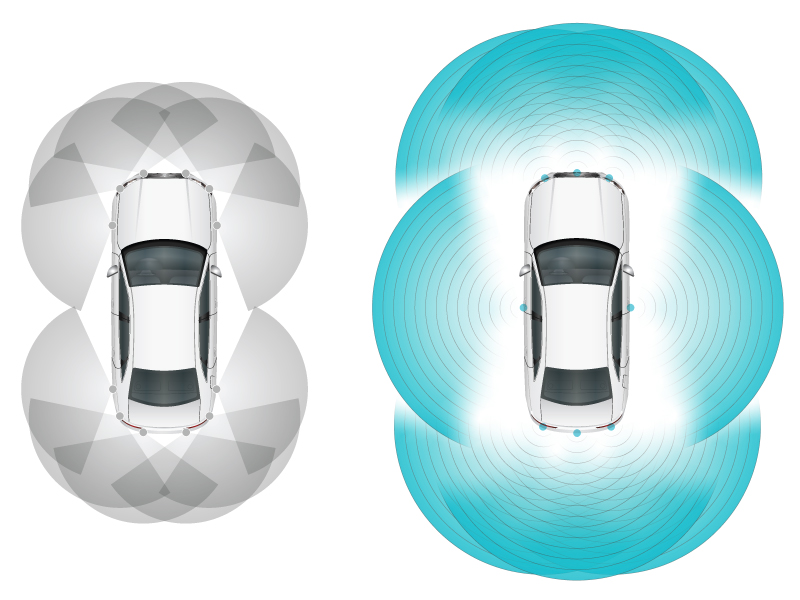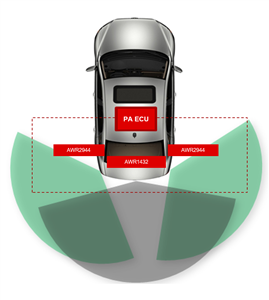SSZTD01 October 2023 AWRL1432
Today’s parking systems primarily use ultrasonic sensors, a low-cost solution that can detect objects nearby. Although this technology is well-established, original equipment manufacturers (OEMs) must meet evolving requirements for parking assistance and autonomous parking applications in a cost-sensitive market, while tier-1 manufacturers see diminishing returns on their efforts to extract more performance from ultrasonic sensing.
The next generation of parking assistance, autonomous parking, and valet parking assist systems will all require detection of the vehicle’s surroundings with greater resolution, accuracy, and range than what is capable with ultrasonic sensing alone.
Where ultrasonic sensors are today
Ultrasonic parking systems vary in autonomy levels, from alerting drivers of detected objects to maneuvering the vehicle into parking spaces with the assistance of camera sensing. As shown in Figure 1, these systems use eight to 12 ultrasonic sensors positioned around the vehicle to achieve full coverage, with a typical detection range of 10 cm to 5 m.
 Figure 1 Comparison of an ultrasonic
sensor (left) and an AWRL1432 sensor (right) parking configuration
Figure 1 Comparison of an ultrasonic
sensor (left) and an AWRL1432 sensor (right) parking configurationUltrasonic sensors detect objects by emitting sound waves that are reflected by objects in its path. They measure the elapsed time between the emission of the sound wave and the reception of its echo to calculate the distance of nearby objects. Today, these sensors typically send the entire waveform of the received signal over high-speed Distributed System Interface (DSI3) channels to a central sensor fusion electronic control unit (ECU).
In contrast to ultrasonic sensors that emit sound waves, millimeter-wave (mmWave) radar sensors detect objects by emitting electromagnetic waves whose frequency increases over time. These signals reflect off of objects in a given pathway. The mmWave sensor measures changes in the properties of the detected objects to calculate their distance, velocity and angle of arrival.
77-GHz mmWave radar has steadily grown in popularity for both advanced driver assistance systems and body applications because of its wide radio frequency bandwidth, which enable precise range and velocity measurements. Despite its low cost, devices such as TI’s AWRL1432 single-chip radar sensor enable the accurate detection of objects in a range of 4 cm to 10 m and beyond, depending on antenna configuration. This extended range detects obstacles earlier, giving drivers more time to react and maneuver safely.
Advantages of using radar sensors for parking assistance
Ultrasonic sensors are optimized for the transmission of sound waves through one type of medium, such as air; thus, environmental conditions like mud, rain and fog can limit its performance. In contrast, the electromagnetic waves used by mmWave radar do not require a transmission medium, and can provide precise object detection under any external condition. Radar sensors are also generally less prone to false readings than ultrasonic sensors, offering a reliable solution for parking assistance functions.
Also, because ultrasonic sensors are affected by the mediums through which their sound waves propagate, installing an ultrasonic parking system in a vehicle involves a difficult process of drilling and painting holes in the bumper, incurring a significant cost to OEMs. In contrast, mmWave radar sensors can be mounted on the vehicle bumper as shown in Figure 2, simplifying installation while preserving aesthetics.
TI’s AWRL1432 mmWave radar sensor integrates the analog front end with a digital processing back end, enabling the transfer of processed output data over a cost-effective Controller Area Network Flexible Data-Rate channel for decision-making by the central ECU. The DSI3 cabling required to communicate waveform data from ultrasonic sensors to the central ECU is expensive in comparison. You can also use the AWRL1432 sensor in conjunction with existing corner radars on vehicles, which are becoming commonplace, allowing for multipurpose sensor reuse in an increasingly space-constrained sensing system.
 Figure 2 A multimode corner radar system with the AWRL1432
Figure 2 A multimode corner radar system with the AWRL1432Conclusion
The AWRL1432 sensor provides greater range, resolution and accuracy to help meet today’s requirements for not just parking assistance but entry-level blind-spot detection and higher-autonomy future applications such as valet parking. Its low-power architecture requires less active power and introduces idle and deep-sleep modes, offering the benefits of radar in kick-to-open and door-sensing applications that require battery power.
The AWRL1432 sensor not only enables OEMs and tier-1 manufacturers to improve radar performance in parking systems, but also enables implementation into exterior applications previously gated by cost and power. These features enable the development of software-defined, multipurpose radar that can reuse the same hardware and shorten engineering cycles across applications for the next generation of near-field sensing.